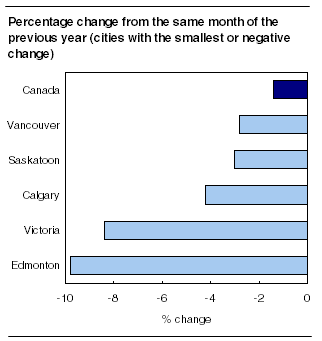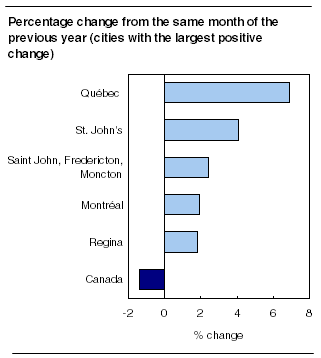Common menu bar links
New Housing Price Index
Archived Content
Information identified as archived is provided for reference, research or recordkeeping purposes. It is not subject to the Government of Canada Web Standards and has not been altered or updated since it was archived. Please "contact us" to request a format other than those available.
Related subjects
The New Housing Price Index rose 0.4% in November following a 0.3% increase in October. The monthly index has been steadily increasing since July 2009.
Between October and November, prices increased the most in St. Catharines–Niagara (+1.4%), Québec (+0.9%) and St. John's (+0.7%) and Windsor (+0.7%).
In Québec, St John's and St. Catharines–Niagara, prices rose as builders reported higher material and labour costs. In the latter metropolitan area, the increase in prices was also attributed to improving market conditions.
In Windsor, a number of builders reported improving market conditions, which led to higher prices.
Of the 21 metropolitan areas surveyed, 3 recorded monthly declines in new housing prices: Hamilton (-0.2%), Saskatoon (-0.2%) and Greater Sudbury and Thunder Bay (-0.1%).
In Hamilton, some builders offered discounts and negotiated lower selling prices in order to generate sales.
Lower material and labour costs contributed to the decrease of new housing prices in Saskatoon.
Year over year, the New Housing Price Index was down 1.4% in November following a 2.1% decline in October 2009. New housing prices continued to fall in Western Canada, albeit at a slower pace than in previous months.
On the Prairies, 12-month declines were recorded in Edmonton (-9.8%), Calgary (-4.2%) and Saskatoon (-3.0%).

Year-over-year declines were also reported in the West Coast cities of Victoria (-8.4%) and Vancouver (-2.8%).
For the second consecutive month, the largest year-over-year increase was registered in Québec (+6.9%). Higher residential land values remained the primary reason for the advance.
On a year-over-year basis, prices also increased in St. John's (+4.1%) and in Saint John, Fredericton and Moncton (+2.4%). Contractors' selling prices were also higher in Montréal (+1.9%) and Regina (+1.8%).

Available on CANSIM: table 327-0005.
Definitions, data sources and methods: survey number 2310.
The third quarter 2009 issue of Capital Expenditure Price Statistics (62-007-X, free) will soon be available.
For more information, or to enquire about the concepts, methods or data quality of this release, contact Client Services (613-951-3902; toll-free 1-866-230-2248; fax: 613-951-3117; prices-prix@statcan.gc.ca), Producer Prices Division.
Table 1
| November 2009 | November 2008 to November 2009 | October to November 2009 | |
|---|---|---|---|
| (1997=100) | % change | ||
| Canada total | 155.4 | -1.4 | 0.4 |
| House only | 164.0 | -1.1 | 0.5 |
| Land only | 137.9 | -2.3 | 0.2 |
| St. John's | 184.4 | 4.1 | 0.7 |
| Charlottetown | 120.4 | 0.8 | 0.0 |
| Halifax | 151.1 | 0.7 | 0.3 |
| Saint John, Fredericton and Moncton | 121.1 | 2.4 | 0.1 |
| Québec | 170.4 | 6.9 | 0.9 |
| Montréal | 166.8 | 1.9 | 0.4 |
| Ottawa–Gatineau | 171.4 | 1.3 | 0.0 |
| Toronto and Oshawa | 147.0 | 0.4 | 0.5 |
| Hamilton | 151.0 | -0.9 | -0.2 |
| St. Catharines–Niagara | 157.4 | 1.2 | 1.4 |
| London | 145.1 | 1.3 | 0.5 |
| Kitchener | 143.8 | 0.9 | 0.5 |
| Windsor | 104.0 | 0.4 | 0.7 |
| Greater Sudbury and Thunder Bay | 112.6 | -0.1 | -0.1 |
| Winnipeg | 183.5 | 1.2 | 0.1 |
| Regina | 253.1 | 1.8 | 0.1 |
| Saskatoon | 213.0 | -3.0 | -0.2 |
| Calgary | 233.6 | -4.2 | 0.4 |
| Edmonton | 207.0 | -9.8 | 0.1 |
| Vancouver | 117.2 | -2.8 | 0.3 |
| Victoria | 106.3 | -8.4 | 0.0 |

